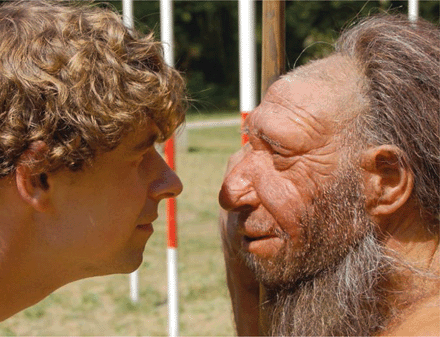
Between a hundredth and a twenty-fifth of those of us non-Africans is Neandertal! (Modern Africans as a race have little or no Neandertal DNA.)
The report issued today in Science radically changes our view of ourselves. It was only one year ago this week that Sarah Tishkoff of the University of Pennsylvania reported that essentially all people alive today were more or less pure ancestors of a small band of hominins that crossed over from Africa 50,000 years ago.
Not necessarily so.
Quite likely that band prospered, moved north and interbred with another type of hominin, the Neanderthal. Or maybe that band went extinct or was absorbed by a group of hominins already living in Europe that had already interbred with Neandertal!
Maybe… Neandertal and we, homo sapiens, are one and the same species, after all?
This is great, joyous science! How different, for example, it is from the secretive, arrogant paleoanthropology of Ardi announced not too long ago.
This is open to us all, to the world, and it is breath-taking!
At this point I should direct all of you not to the report itself, but to those brilliant and affable scientists who can translate it into terms we can all understand. There are many of these wonderful individuals, but my favorite is the University of Wisconsin’s John Hawks.
Today’s report in Science is probably the most exciting research on close-to-modern hominins ever seen. And not a single element of that report came from the field.
It all came from… DNA.
You remember that the human genome project started in 1990 and took about 13-14 years to complete, and that by 2004 we had a nearly complete working blueprint of our genes.
They did it with Neandertal in about two years. The Max Planck Institute mapped the genome of Neandertal from five species found in Europe from a bone powder weighing less than an aspirin.
To come to the amazing conclusions they did, they had to compare the Neandertal genome not only to our genome, but also to chimp’s.
And by simultaneously looking at the sections of the Neandertal and modern man genome that differ from a modern chimp’s, the most groundbreaking science was achieved: some of us modern humans have more divergence from Neandertal DNA than others. Modern Asians carry more Neandertal DNA than modern Africans.
That means our common modern human ancestors, the guys who previously we thought wiped out the Neandertals when they met them… didn’t. They absorbed them into the population and probably before migrating east to Asia. (There’s no evidence, yet, that Neandertals got themselves to Asia.)
The report also took a first look at some of the genes we now carry that likely came from Neandertals. (It will take much longer, and may never be possible to find them all.) And reexamined genes of importance that we absolutely don’t have from Neandertals.
Why would that be? Why do we carry some of the genes and not others?
Because some worked and some didn’t for evolving us. We’ve known for some time, for example, that really important genes, ones that effect energetics, longevity, and our brain, don’t come from the Neandertal. These are the dynamite genes carried in the mitochondrial DNA that has been available for examination for more than a few years.
Genes relating to our brain functions, stamina and life span didn’t come from Neandertal. It’s a stretch but not entirely unfair to conclude that may be some of the reasons Neandertal went extinct: because they didn’t share these important characteristics with our ancestoral lineage.
And genes relating to diabetes and a few rare diseases did come from Neandertals. As did certain genes relating to “cognition.” But since we still don’t really know how these genes even in modern humans translate into the workings of diabetes, these rare diseases or “cognition”, we don’t of course know how to determine if this was useful or not in our own modern evolution.
There is so much science left to do! And what’s amazing is that this type of science is done mostly in front of a computer screen, not out brushing pumice away from fossils.
And finally one of the most awesome aspects of this science, which continues from the genome project itself, is that it is all PUBLIC. Everything, every discovery, every postulate, every tool and method is on the internet.
It’s there for every cerebral scientist to use to further his own intricate theories, as it’s there for an 8th grader to create a science project.
Kudus to these guys: University of California’s Richard E. Green and a host of others, and Max Plank’s Hernán A. Burbano and a host of others.